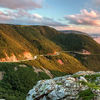
Wadi Darbat: Natural wonder with wild animals


The lush valley: Wadi Darbat
The subtropical Dhofar region in the south of Oman boasts a variety of natural landscapes – from the jungle to the desert. One of the most beautiful destinations is the Wadi Darbat in the Dhofar Mountains. It’s an ecological gem that is home to many migratory birds and endangered species, including the Arab Leopard, and flocks of camels are often seen roaming wild here as there is a freshwater lake in the valley. Even in winter, when the riverbed is dry, this imposing landscape is worth a visit. A rental car from Salalah will get you there in 40 minutes, where you should spend at least half a day exploring the valley.

Fantastic noise: the Darbat waterfalls
The river that flows through the Wadi Darbat is fed by the surrounding mountains. During the Khareef season (southwest monsoon) between June and September, the river carries so much water that it falls in six adjacent cascades into a wide grotto with turquoise water and white sand. This amazing waterfall is the highlight of the Wadi Darbat – a must for anyone visiting this area. To see it, you need firm footwear, but it’s only about 20 minutes to walk from the car park. Since there are many tourists travelling here during the day, it is recommended to get there as early as possible.


A boat tour through the valley
Unfortunately, bathing is not permitted in the waters of the Wadi Darbat. But it does offer boat hire on the lake including kayaks, canoes and pedalos. This allows you to take a river tour through the valley and explore the landscape from the water. You can see weaver bird nests hanging in the branches, hear frogs croaking and sometimes dromedaries can be found cooling off in the crystal clear water. Amidst it all, hundreds of fish are on the move. And on the banks there are idyllic spots enticing you to get out and enjoy a picnic. The best way to do this is to buy provisions directly in the car park.


A paradise for wild animals
The Wadi Darbat offers a wide variety of wildlife, and if you are well-informed and attentively wandering through the valley, you can see exotic species of birds, reptiles and mammals. The endangered Arab Leopard, which is said to inhabit this valley, is unlikely to be spotted live due its extreme shyness. But the chance to discover an equally rare black Verreaux’s eagle (also known as the “black eagle”) is much greater. The females have a wing span of up to 2.5 metres – so there is no chance of missing them when they are circling in the air above.

Hiking at Wadi
The valley has numerous, extensive hiking trails that offer very beautiful views of the surrounding mountains. Those who are sure-footed can hike through the valley along the riverbed for two to four hours. This is particularly good in the dry months of winter. The unusual, somewhat rough charm of this landscape leaves unforgettable impressions. The wild paths make it possible to find quiet places even with a high number of visitors: The further away you are from the direct route to the waterfall, the fewer visitors you come across – which is rewarding in itself.

Picnic with local delicacies
A spectacular spot like the Wadi Darbat is the ideal place for a plentiful picnic with regional specialities. The best way to buy these things is at a souk, i.e. a marketplace: mixed appetizers (mezze), dates and other fruits, hummus, falafel, flatbread and cheese. There are many shaded places under the trees in the valley from which you can admire the magnificent landscape whilst eating. Arabic families like to do this at the weekend. When eating in Oman, only use the right (clean) hand to eat with. Alcohol is not allowed outdoors, or alternatively you can get very good fresh fruit juices.

Tawi Atair Sinkhole: Have a look into the inside of the earth
After the Wadi Darbat trip, it is a good idea to go up to the Tawi Atair Sinkhole. This is a 211 metre-deep limestone depression with very steep edges. Such dolines – sometimes also referred to as “depressions” – are created by slow dissolution of the limestone in the subfloor or by the collapse of a cavity after underground drainage. The Tawi Atair Sinkhole is the deepest doline in the Middle East and the view of this cliff is extremely impressive.


Ascension to Jabal Samhan
Many also combine the visit to the Wadi Darbat with a flying visit to the almost 1,300-metre high vantage point of Jabal Samhan. The one-hour drive takes you directly into the clouds – which is a special experience in itself. If you’re lucky and catch a clear day, you can look up at Salalah and out to the ocean from there. At 2,100 metres high, the Jabal Samhan is the highest summit in Oman. There is still the occasional Arabian Tahr, a goat-like hoofed animal, which is among the highly endangered species. Maybe you will discover one.








